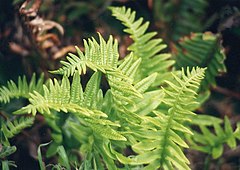Polypodiales
| Polypodiales | |
|---|---|

| |
| Polypodium californicum | |
| Scientific classification | |
| Kingdom: | |
| Division: | |
| Class: | |
| Order: | Polypodiales Link (1833)
|
| Families | |
|
See text. | |
The order Polypodiales encompasses the major lineages of polypod ferns, which comprise more than 80% of today's fern species. They are found in many parts of the world including tropical, semitropical and temperate areas. The characteristics of this group include: sporangia with a vertical annulus interrupted by the stalk and stomium; indusia laterally or centrally attached (or lost); gametophytes green, chordate, and surficial.[1]
Polypodiales may be regarded as one of the most evolutionarily advanced orders of monilophytes (ferns), based on recent genetic analysis. They arose and diversified about 100 million years ago, probably subsequent to the diversification of the angiosperms. [2]
Families
The Polypodiales order includes the following families.[3][4][5] The order in which they are listed is based on the order in which they appear in the phylogram that follows the list. The classification used here follows that of Christenhusz & Chase (2014)[6]
- Saccolomataceae Doweld & Reveal (2008)
- Cystodiaceae J.R.Croft (1986)
- Lonchitidaceae C.Presl ex M.R.Schomb. (1848)
- Lindsaeaceae C.Presl ex M.R.Schomb. (1848)
- Dennstaedtiaceae Lotsy (1909)
- Pteridaceae E.D.M.Kirchn. (1831)
- Cryptogrammoideae S.Linds. (2009) (=) Cryptogrammaceae Pic. Serm. (1963)
- Ceratopteridoideae (J.Sm.) R.M.Tryon (1986) (=) Ceratopteridaceae Underw. (1900)
- Pteridoideae C.Chr. ex Crabbe, Jermy & Mickel (1975)
- Cheilanthoideae W.C.Shieh (1973) (=) Cheilanthaceae B.K.Nayar (1970)
- Vittarioideae (C.Presl) Crabbe, Jermy & Mickel (1975) (=) Adiantoideae (C.Presl) R.M.Tryon (1986)
- Aspleniaceae Newman (1840) s.l. (=) eupolypods II
- Cystopteridoideae Ching & Z.R.Wang (1997) (=) Cystopteridaceae Shmakov (2001)
- Rhachidosoroideae M.L.Wang & Y.T.Hsieh (2004) (=) Rhachidosoraceae X.C. Zhang (2011)
- Diplaziopsidoideae Christenh. (2014) (=) Diplaziopsidaceae X.C.Zhang & Christenh. (2011)
- Asplenioideae Link (1841) s.l. (=) Aspleniaceae s.s.
- Thelypteridoideae C.F.Reed (1968) (=) Thelypteridaceae Ching ex Pic.Serm. (1970)
- Woodsioideae Fomin (1911) (=) Woodsiaceae Herter (1949)
- Blechnoideae Hook. (1859) (=) Blechnaceae Newman (1844)
- Athyrioideae B.K.Nayar (1970) (=) Athyriaceae Alston (1956)
- Polypodiaceae J.Presl & C.Presl (1822) s.l. (=) eupolypods I
- Hypodematioideae Christenh. (2014) (=) Hypodematiaceae Ching
- Dryopteridoideae Link (1841) (=) Dryopteridaceae Herter (1949)
- Lomariopsidoideae Crabbe, Jermy & Mickel (1975) (=) Lomariopsidaceae Alston (1956)
- Tectarioideae B.K.Nayar (1970) (=) Tectariaceae Panigrahi (1986)
- Oleandroideae Crabbe, Jermy & Mickel (1975) (=) Oleandraceae Ching ex Pic. Serm. (1965)
- Davallioideae Hook. (1845) (=) Davalliaceae M.R.Schomb. ex A.B.Frank (1848)
- Polypodioideae Sweet (1826) s.l. (=) Polypodiaceae s.s.
- Loxogrammeae R.M.Tryon & A.F.Tryon (1982) (=) Loxogrammoideae H.Schneid. (2011)
- Drynarieae Subh.Chandra (1982) (=) Drynarioideae Crabbe, Mickel & Jermy (1975)
- Platycerieae Christenh. (2014) (=) Platycerioideae B.K.Nayar (1970)
- Microsoreae V.N.Tu (1981) (=) Microsoroideae B.K.Nayar (1970)
- Polypodieae Hook. & Lindl. ex Duby (1828) (=) Polypodioideae s.s.
Phylogenic relationships
The following diagram showing a likely phylogenic relationship between the families of the Polypodiales is based on Lehtonen (2011),[3] Rothfels & al. (2012),[7] and Christenhusz & Chase (2014).[6] The classification followed here is that of Christenhusz & Chase (2014).[6]
| Polypodiales | |
Obsolete families
Now-obsolete families of Polypodiales include:
- Drynariaceae - now in Polypodiaceae
- Grammitidaceae - now in Polypodiaceae
- Gymnogrammitidaceae - now in Polypodiaceae
- Loxogrammaceae - now in Polypodiaceae
- Nephrolepidaceae - now in Lomariopsidaceae
- Platyceriaceae - now in Polypodiaceae
- Pleursoriopsidaceae - now in Polypodiaceae
- Vittariaceae - now in Pteridaceae
References
- ^ Alan R. Smith, Kathleen M. Pryer, Eric Schuettpelz, Petra Korall, Harald Schneider & Paul G. Wolf; Pryer; Schuettpelz; Korall; Schneider; Wolf (2006). "A classification for extant ferns" (PDF). Taxon. 55 (3): 705–731. doi:10.2307/25065646. JSTOR 25065646.
{{cite journal}}: CS1 maint: multiple names: authors list (link) - ^ Harald Schneider, Eric Schuettpelz, Kathleen M. Pryer, Raymond Cranfill, Susana Magallón, Richard Lupia; Schuettpelz; Pryer; Cranfill; Magallón; Lupia (2004), "Ferns diversified in the shadow of angiosperms", Nature, 428 (6982): 553–557, doi:10.1038/nature02361, PMID 15058303
{{citation}}: CS1 maint: multiple names: authors list (link) - ^ a b Samuli Lehtonen (2011). "Towards Resolving the Complete Fern Tree of Life" (PDF). PLoS ONE. 6 (10): e24851. doi:10.1371/journal.pone.0024851. PMC 3192703. PMID 22022365.
{{cite journal}}: CS1 maint: unflagged free DOI (link) - ^ Maarten J. M. Christenhusz, Xian-Chun Zhang & Harald Schneider (2011). "A linear sequence of extant families and genera of lycophytes and ferns" (PDF). Phytotaxa. 19: 7–54.
- ^ Maarten J. M. Christenhusz; Harald Schneider (2011). "Corrections to Phytotaxa 19: Linear sequence of lycophytes and ferns" (PDF). Phytotaxa. 28: 50–52.
{{cite journal}}: Unknown parameter|lastauthoramp=ignored (|name-list-style=suggested) (help) - ^ a b c Christenhusz, Maarten J.M.; Chase, Mark W. (2014). "Trends and concepts in fern classification". Annals of Botany. 113 (9): 571–594. doi:10.1093/aob/mct299.
{{cite journal}}: Unknown parameter|lastauthoramp=ignored (|name-list-style=suggested) (help) - ^ Carl J. Rothfels; Anders Larsson; Li-Yaung Kuo; Petra Korall; Wen- Liang Chiou; Kathleen M. Pryer (2012). "Overcoming Deep Roots, Fast Rates, and Short Internodes to Resolve the Ancient Rapid Radiation of Eupolypod II Ferns". Systematic Biology. 61 (1): 70. doi:10.1093/sysbio/sys001. PMID 22223449.
